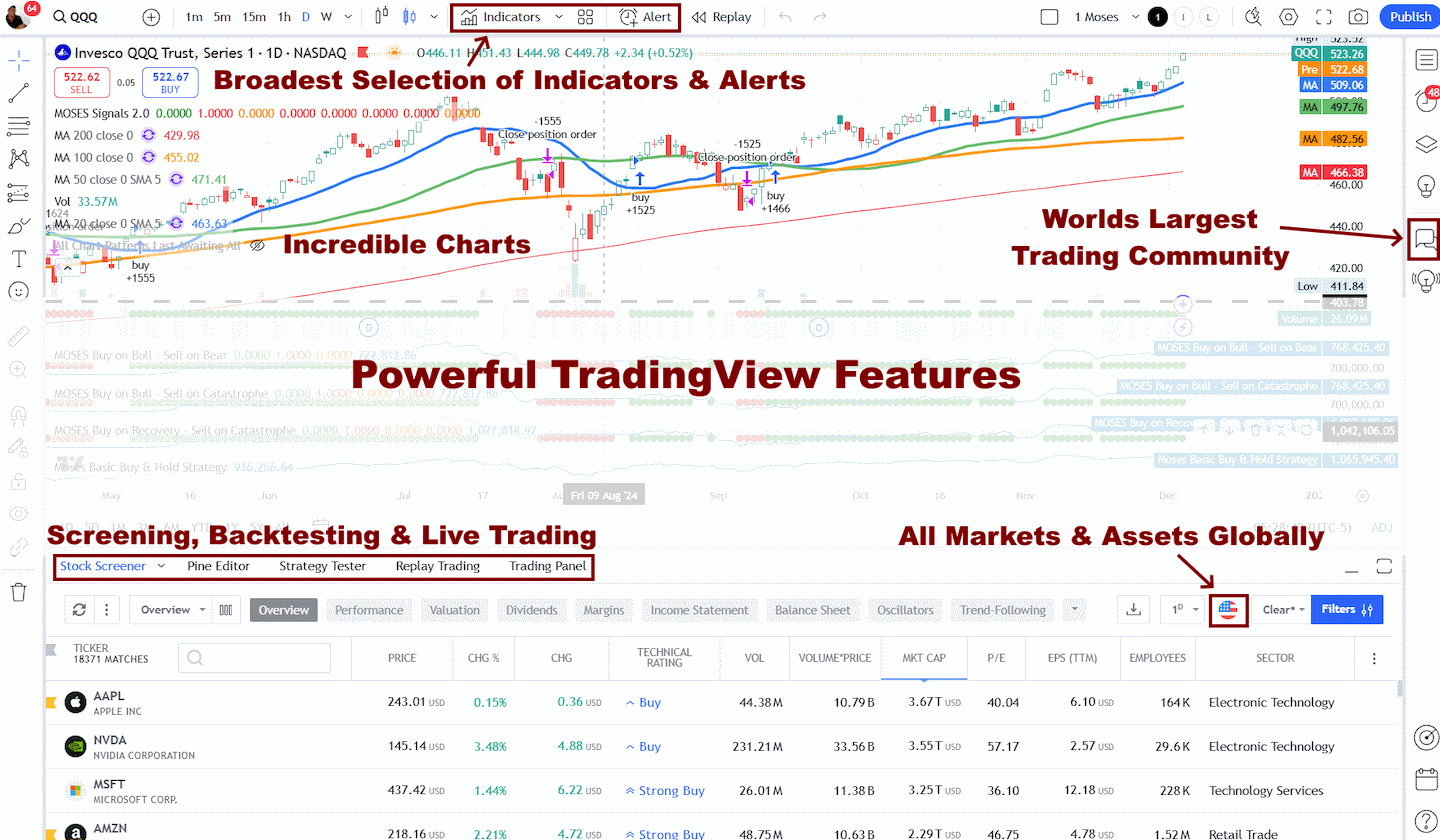In a stock split, a company divides its existing shares into multiple shares to increase liquidity.
A reverse stock split combines several shares into one to reduce outstanding shares.
Splits alter the share price, attracting potential investors, but can you trade it for a profit?
In this article, we will break down these concepts, explain why companies choose to split, and how they impact an individual’s investment.

What is a Stock Split?
A stock split is a corporate action where a company increases the number of its outstanding shares by issuing more to current shareholders. For example, in a 2-for-1 split, every shareholder gets an additional share for each share they own. Consequently, the price per share drops, but the total value of shares held remains the same.
Why Do Companies Split Stocks?
Companies usually split stocks to make shares more affordable to small investors and increase liquidity. A lower share price can attract more participation from retail investors, potentially boosting demand and share price over time.
Types of Stock Splits
There are several stock splits, including 2-for-1, 3-for-1, and even 10-for-1. In a 2-for-1 split, every shareholder gets an additional share for each share they own, effectively halving the share price. Similarly, in a 3-for-1 split, each shareholder receives two additional shares, reducing the share price to a third. The principle remains the same for 10-for-1 splits or any other ratio. The total value of an investor’s shares does not change during a stock split.
What is a Reverse Stock Split?
A reverse split is the opposite of a stock split. It reduces the number of shares a company has outstanding by consolidating existing shares into fewer ones. For instance, in a 1-for-5 reverse split, every five shares an investor owns are combined, increasing the share price fivefold. The overall value of the investor’s holding remains unchanged.
My thorough testing awarded TradingView a stellar 4.8 stars!
With powerful stock chart analysis, pattern recognition, screening, backtesting, and a 20+ million user community, it’s a game-changer for traders.

Whether you're trading in the US or internationally, TradingView is my top pick for its unmatched features and ease of use.
Explore TradingView – Your Gateway to Smarter Trading!
Why Do Companies Perform Reverse Stock Splits?
Reverse stock splits often occur with small companies whose share price is too low to attract investors or meet exchange listing requirements. By reducing the number of outstanding shares, a company can increase its share price without affecting its overall market value.
Real-World Stock Split Examples
Corporate giants like Apple, Tesla, and Moster Beveridge have recently undergone stock splits to make their shares more accessible.
Stock Split Example: Tesla
Tesla initiated a 3-for-1 stock split in August 2022. This means that each share of Tesla (TSLA), an investor-owned, received an additional two shares. Consequently, the number of outstanding shares tripled, and the price per share was reduced to a third.
The total market capitalization, the total value of all the company’s shares, remained unchanged. This is because while the number of shares increased, the price per share decreased proportionately.
Tesla Stock Split Chart Example
This chart shows the impact of the stock split on Tesla’s share price. Price increased into the split and then continued its previous downtrend after the split.
View this Chart on TradingView
Why Did Tesla Split Its Stock?
Tesla split its stock to make the shares more accessible to individual investors, expanding its investor base. Companies often conduct stock splits when their share price becomes too high for average retail investors to afford. By lowering the share price through a stock split, more investors can participate, potentially increasing liquidity and demand.
Impact on Tesla Investors
Due to the split, the value of their investment remained the same for existing shareholders. If an investor held 100 shares priced at $900 each before the split, their total investment was worth $90,000. After the split, they held 300 shares priced at $300 each, with the investment still worth $90,000.
However, the lower share price post-split may attract new investors who were previously priced out, potentially boosting demand and leading to future price appreciation.
Key Takeaways
Tesla split its stock, demonstrating how companies use stock splits to manage share prices and attract more investors. Although the split didn’t affect the company’s market value, it changed the number and price of shares, potentially impacting the market and investor perception.
Stock Split Example: Monster Beverage
In March 2023, Monster Beverage Corporation implemented a 2-for-1 stock split. This means that for each share of Monster Beverage (MNST) that an investor owned, they received an additional share. As a result, the number of outstanding shares doubled, halving the price per share.
The total market capitalization, the total value of all the company’s shares, remained unchanged. This is because while the number of shares increased, the price per share decreased proportionately.
Monster Beverage Stock Split Chart Example
This chart shows that the Monster Beverage stock split was successful, leading to a stock price rally after the split.
Why Did Monster Beverage Split Its Stock?
Monster Beverage split its stock to make the shares more affordable to individual investors, thus expanding its investor base. Companies often split their stocks when the share price becomes too high for average retail investors to afford. By lowering the share price through a stock split, more investors can participate in the market, potentially increasing liquidity and demand.
Impact on Monster Beverage Investors
The value of their investment didn’t change for existing shareholders due to the split. If an investor held 100 shares priced at $80 each before the split, their total investment was worth $8,000. After the split, they held 200 shares priced at $40 each, with the investment still worth $8,000.
However, the lower share price post-split may attract new investors who were previously priced out, potentially boosting demand and leading to price appreciation in the future.
Key Takeaways
The recent Monster Beverage stock split offers a practical example of companies using stock splits to manage their share price and broaden their investor base. While the split did not alter the company’s overall market value, it changed the number of shares in circulation and the price per share, potentially influencing market dynamics and investor perception.
Reverse Stock Split Example: Helios and Matheson Analytics
In July 2018, Helios and Matheson Analytics, the parent company of MoviePass, implemented a 1-for-250 reverse stock split. This meant that for every 250 shares of Helios and Matheson Analytics (HMNY), an investor-owned, they received one new share.
Consequently, the number of outstanding shares drastically reduced, and the price per share significantly increased.
The total market capitalization, the total value of all the company’s shares, remained unchanged. This is because while the number of shares decreased, the price per share increased proportionately.
Helios and Matheson Reverse Stock Split Chart
This Helios and Matheson Analytics chart demonstrates how a reverse stock split cannot save a company if the company business is failing. The company originally split in July 2018, at which time the stock price decreased to $0.01 per share.
Although the per-share price increased substantially, it could not sustain itself and eventually fell back to $0.01 per share.
This chart is a reminder of why it’s important to research a company before investing in it and how even a reverse stock split may not be enough to save a failing business.
Why Did They Conduct a Reverse Stock Split?
Helios and Matheson Analytics conducted a reverse stock split to boost its share price and regain compliance with Nasdaq’s minimum bid price requirement. Companies often implement reverse stock splits when their share price is too low to meet exchange listing requirements or attract investors. By reducing the number of outstanding shares, a company can increase its share price without affecting its overall market value.
Impact on Helios and Matheson Investors
Due to the split, the value of their investment remained the same for existing shareholders. If an investor held 25,000 shares priced at $0.01 each before the split, their total investment was worth $250. After the split, they held 100 shares priced at $2.50 each, with the investment still worth $250.
However, the higher share price post-split can deter new small investors, potentially affecting liquidity and demand.
Key Takeaways
The recent Helios and Matheson Analytics reverse stock split provides a practical example of how companies use reverse stock splits to manage their share price and maintain their exchange listing status. While the split did not alter the company’s overall market value, it changed the number of shares in circulation and the price per share, potentially influencing market dynamics and investor perception.
Stock Split Trading Strategies
By understanding the dynamics of stock splits and developing tailored trading strategies, investors can leverage these events to potentially enhance their portfolio returns. This article explores some prevalent stock split trading strategies.
Buy Before the Split
Some investors buy shares before a split, assuming that the lower price per share will attract more investors post-split, driving up demand and potentially leading to price appreciation.
Short-term Trading
After a split, the stock price often reverts toward its pre-split level. Traders can capitalize on this by buying shares immediately after the split, hoping to sell them at a higher price as the stock price adjusts.
Bullish Split-Strike Synthetic Position
This strategy involves buying a call option with a higher strike price and selling a put option with a lower strike price. It’s a bullish strategy that benefits if the stock price rises significantly after the split.
Straddle Strategy
The straddle strategy involves buying both a call and a put option with the same strike price and expiration. This strategy can turn a profit if the stock’s price moves significantly in either direction, as may occur following a stock split announcement.
Important Stock Split Dates
When trading stock splits, investors should be aware of three key dates:
- Announcement Date: The day the company announces its intention to split the stock.
- Record Date: The date investors must be on record as shareholders to receive the additional shares.
- Effective Date: The day the stock begins trading on a split-adjusted basis.
You want to be a successful stock investor but don’t know where to start.
Learning stock market investing on your own can be overwhelming. There’s so much information out there, and it’s hard to know what’s true and what’s not.
Liberated Stock Trader Pro Investing Course
Our pro investing classes are the perfect way to learn stock investing. You will learn everything you need to know about financial analysis, charts, stock screening, and portfolio building so you can start building wealth today.
★ 16 Hours of Video Lessons + eBook ★
★ Complete Financial Analysis Lessons ★
★ 6 Proven Investing Strategies ★
★ Professional Grade Stock Chart Analysis Classes ★
What Are the Benefits and Risks of Stock Splits?
Though stock splits are typically beneficial to shareholders in the long run, they can also pose some risks. Some investors may be tempted to buy large amounts of split stocks on speculation without understanding their underlying fundamentals.
Additionally, if a company performs a stock split to boost its share price in the short term, investors may be misled into buying overvalued shares.
Conclusion
Stock splits and reverse stock splits are critical tools that companies use to manage their share price. While these actions do not alter a company’s inherent value, they can influence market dynamics and an investor’s perception of a stock.
FAQ
What software is best for tracking stock splits?
Investors interested in tracking stock splits should consider investing in portfolio management software like Stock Rover. Those interested in trading stock splits should try TradingView.
What is a reverse stock split?
A reverse stock split reduces the total number of outstanding shares. For example, if a company with 1 million shares worth $1 performs a one-for-five reverse split, it would then have only 200,000 shares, and each share would be $5.
What is the purpose of a reverse stock split?
The primary purpose of a reverse stock split is to increase a company's stock price by reducing its total number of shares, making it appear more attractive to investors.
When did Tesla stock split?
Tesla had a 5-for-1 stock split in August 2020. This increased the total number of shares from approximately $208 million to around 1.08 billion. The value of each share decreased by a factor of five, but investors owning these shares before the split saw their holdings increase by the same factor.
Are reverse stock splits bad?
Not necessarily. While it is true that reverse stock splits can signal trouble for a company, they do not always indicate bad news. Sometimes, the split is intended to make the stock more attractive to investors and increase its market value.
How to profit from a reverse stock split?
For investors looking to profit from a reverse stock split, the key is to focus on the company's underlying fundamentals. If the company has strong financials and growth prospects, buying shares before the split can be profitable.
What happens when a stock splits?
When a stock splits, the total number of shares increases, and the price of each share decreases. This makes the stock more accessible to smaller investors and can sometimes increase its market value due to increased demand.
Is a reverse stock split good?
Yes and No! A reverse stock split can benefit investors if it aims to attract new capital. Buying shares before the split can be profitable if the company has strong fundamentals and growth prospects. However, a reverse stock split may not be beneficial if the business is weak or declining.
What are frequent reasons for stock splits?
The most common reasons for a stock split are to increase liquidity, boost investor confidence, reduce transaction costs, attract institutional investors, and make shares more affordable.
Is a stock split good?
Yes, a stock split is generally a good sign for investors, as it can increase liquidity and provide more affordable entry points into an investment.
References:

